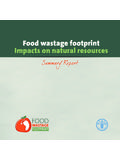Transcription of Food Wastage Footprint & Climate Change
1 food Wastage Footprint & Climate Change The 2012 market value of food products lost or wasted was USD 936 billion; that is in the range of the GDP of countries such as Indonesia or the FAO methodology and estimates (3), the total cost of GHG emissions from global food Wastage is USD 411 food loss and waste generate GtCO2 eq, or about 8% of total anthropogenicGHG emissions (5). This means that the contribution offood Wastage emissions to global warming is almost equivalent (87%) to global road transport emissions (6).
2 0 Gtonnes CO2 eqChinaSource: WRI S Climate Data Explorer (4)USAFood wastageIndiaRussiaJapanBrazilGermanyIndo nesiaMexicoCanadaIranSouth KoreaAustraliaUnited KingdomSaudi ArabiaItalyFranceSouth AfricaTurkeyUkraine24681012 Total GHGs emissions excluding LULUCFTop 20 of countries (year 2011) vs. food wastageIf food Wastage were a country, it would be the third largest emitting country in the food loss and wasteThe 2011 FAO assessment of global food losses and waste (1) estimated that each year, one-third of all food produced in the world for human consumption never reached the consumer s table.
3 This not only means a missed opportunity for the economy and food security, but also a waste of all the natural resources used for growing, processing, packaging, transporting and marketing an extensive literature search, the 2011 assessment of food Wastage volumes gathered weight ratios of food losses and waste for different regions of the world, different commodity groups and different steps of the supply chain. These ratios were applied to regional food mass flows of FAO s food Balance Sheets for the year Wastage arises at all stages of the food supply chains for a variety of reasons that are very much dependent on the local conditions within each country.
4 At a global level, a pattern is clearly visible; in high income regions, volumes of wasted food are higher in the processing, distribution and consumption stages, whereas in low-income countries, food losses occur in the production and post-harvesting phases. In low income countries, the lack of infrastructure and lack of knowledge on proper storage and food handling, combined with unfavourable climatic conditions, favour food spoilage. In higher income countries, aesthetic preferences and arbitrary sell-by dates are factors that contribute to food Footprint of global food wastageFAO quantified the food Wastage Footprint on natural resources (2), most notably its carbon Footprint .
5 Carbon Footprint calculations based on the 2011 assessment of food Wastage volumes (1) and emissions factors taken from Life Cycle Assessment studies wereestimated at GtCO2 eq for 2007 (excluding land use Change ). Using the most recent food Balance Sheets (2011) this figure is updated to GtCO2 eq (see figure below), which does not include the eq of deforestation and managed organic soils associated with the food Wastage (3). Thus the total carbon Footprint of food Wastage , including land use Change , is around GtCO2 eq per year.
6 Products hold different carbon intensities. For example, vegetable production in Europe is more carbon-intensive than vegetable production in Industrialized and Southeast Asia, as Europe uses more carbon-intensive means of production, such as artificially heated greenhouses. Inversely, cereal production in Asia is more carbon intensive than cereal production in Europe due to the difference in the type of cereal grown: rice on average has higher impact factors than wheat.
7 Rice is a CH4 emitting crop because of thedecomposition of organic matter in paddy fields (1 kg of CH4 is the equivalent of 25 kg of CO2). 2 Carbon Footprint intensitiesThe carbon Footprint of a food product is the total amount of GHG emitted throughout its lifecycle, expressed in kilograms of CO2-equivalents. GHG emissions of the production phase (including all agricultural inputs, machinery, livestock, soils) and successive phases (such as processing, transportation, preparation of food , waste disposal)
8 Are all included in this , one kg of wheat, or one kg of beef, have different carbon footprints, since their life cycles are different, emitting specific types and varying amount of greenhouse meat being a relatively low contributor to global food Wastage in terms of volumes (less than 5% of total food Wastage ) it has a significant impact on Climate Change , contributing to over 20% of the carbon Footprint of total food waste (see chart above). This is because meat carbon Footprint includes the emissions from producing a kilogram of meat ( the methane emitted by ruminants), the emissions related to feed provision ( the fertilizer used for the production of feed) and emissions from manure management.
9 Thus, efforts to reduce GHG related to food Wastage should focus on major Climate hotspots commodities, such as meat and of totalCereals(excluding beer)Starchy rootsOilcrops& PulsesFruits(excluding wine)MeatFish& SeafoodVegetablesMilk(excludingbutter) & Eggs10%20%30%Contribution of each commodity to carbon Footprint and food wastageCarbon footprintFood wastage0%% of totalAgriculturalproductionPostharvest handlingand storageProcessingDistributionConsumption 10%20%30%40%Contribution of each phase of the food supply chain to carbon Footprint and food wastageFood wastageCarbon footprintThe further along the chain the food loss occurs, the more carbon intensive is the Wastage .
10 For example, a single tomato spoiled at the harvesting stage will have a lower carbon Footprint than tomato sauce wasted at the retail store, since the harvesting, transportation and processing accumulates additional greenhouse gases along the supply highest carbon Footprint of Wastage occurs at the consumption phase (37% of total), whereas consumption only accounts for 22% of total food Wastage . This is because one kilogram of food that is wasted further along the supply chain will have a higher carbon intensity than at earlier a global average, per capita food Wastage Footprint on Climate in high income countries is more than double that of low income countries, due to wasteful food distribution and consumption patterns in high income countries.













